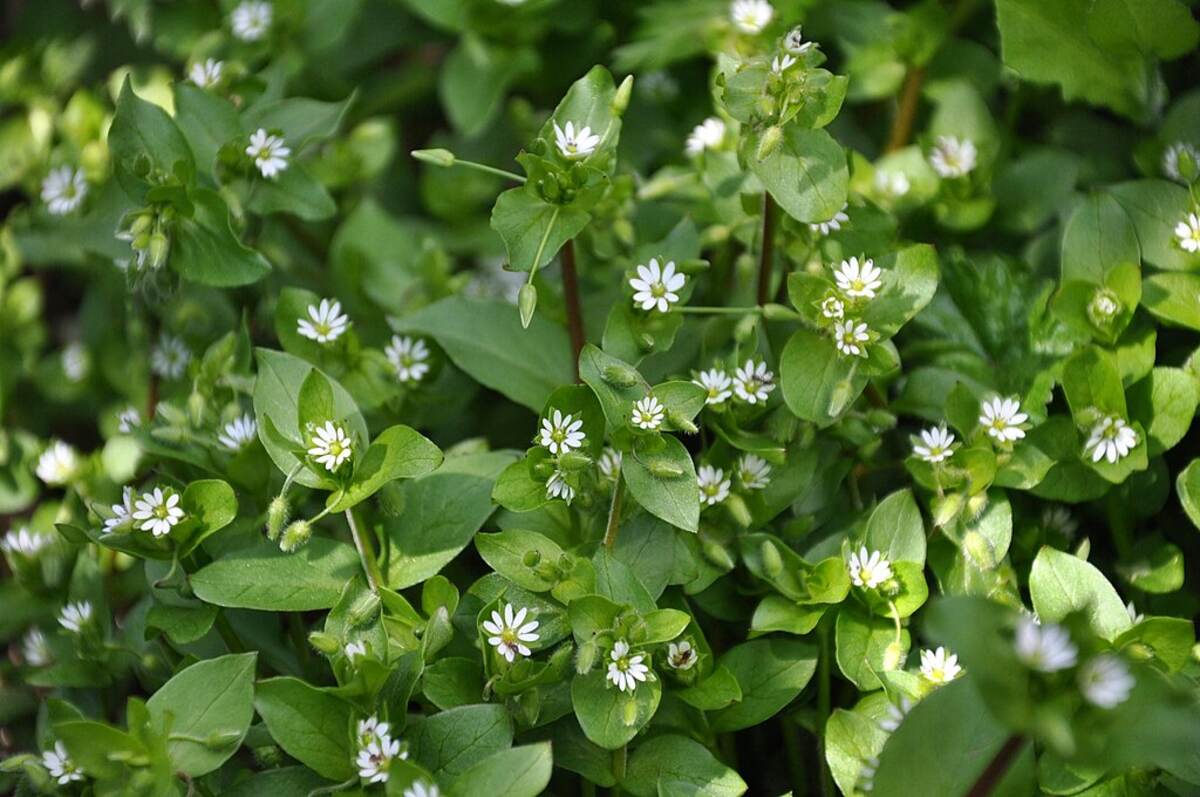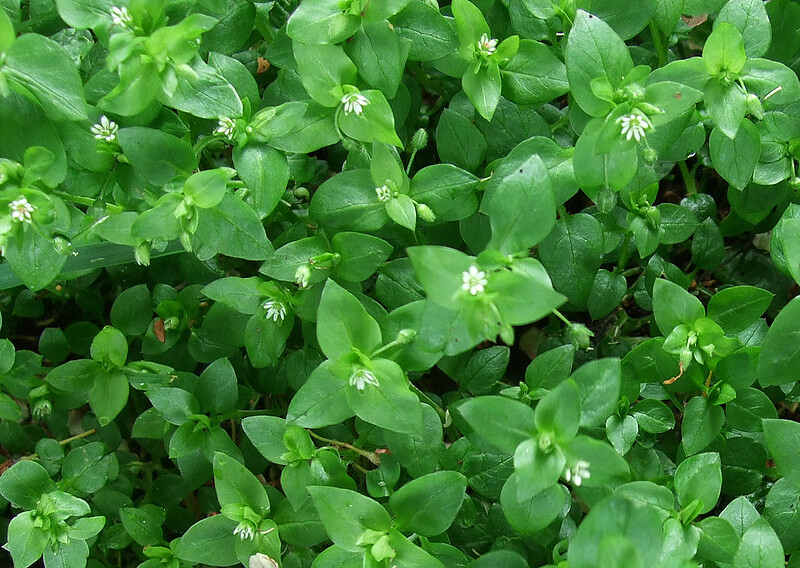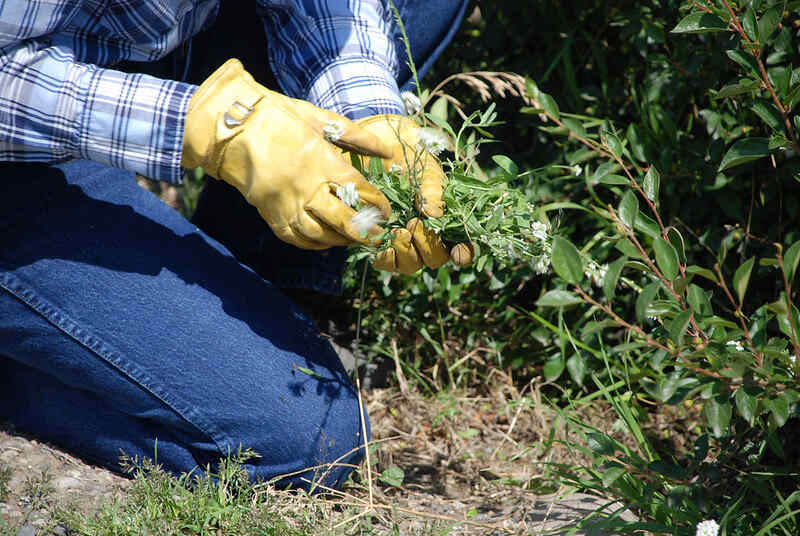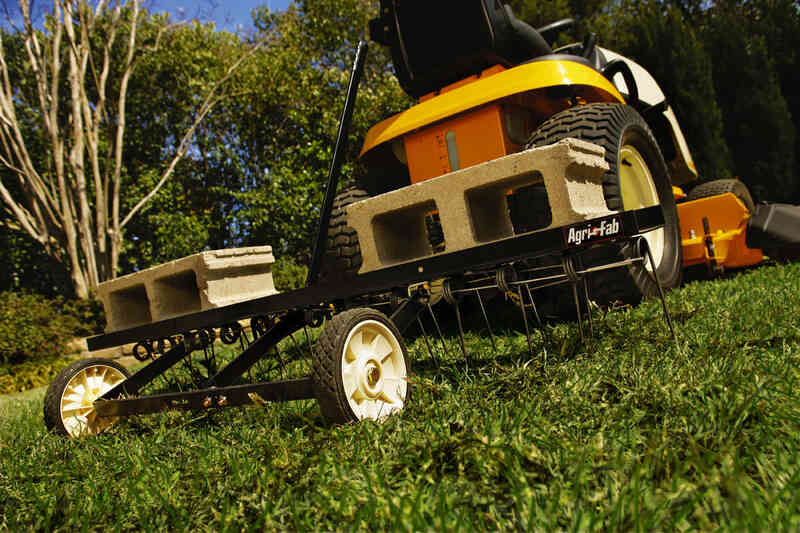
You can spot-treat with herbicides, use natural solutions, or even hand-pull — there are many ways to eliminate chickweed. With advice from an expert, discover the 5 best ways to get rid of chickweed in your landscape.
What is Chickweed?

Common chickweed (Stellaria media) is a broadleaf winter annual that usually appears in home lawns and gardens that are excessively moist, shady, or have drainage problems. Highly adaptable to a variety of environments, chickweed grows rapidly. Its mat-forming growth habit can suffocate desirable turf and favor insect pests and plant diseases.
This broadleaf weed typically germinates in late summer to early fall, but depending on the local climate it can even germinate during early spring, when the soil is warmer, if the soil is overly moist. When chickweed sprouts, you’ll notice low-growing weeds with pointy leaves. It typically reaches around 2 inches in sunny areas or 4 to 6 inches in shaded areas.
Chickweeds also have a characteristic 1 or 2 lines of hairs along the sides of each stem. In early spring or late autumn, you might notice tiny white flowers.
5 Effective Methods to Get Rid of Chickweed

If you see a sea of chickweed sprouting over your lawn or garden beds, here’s how to remove it:
1. Remove By Hand
Hand-pulling lawn chickweed can be a successful strategy when done in the early stages of the weed’s growth, when the plant is still small and before it flowers. It is also a more effective method when dealing with chickweed in smaller areas like garden beds and under trees. This is how to hand-pull chickweed:
- Get a firm grip at the base of the weed
- Pull the chickweed plant out of the soil, making sure you get the roots out.
If the soil is too hard, use a trowel or hoe to loosen it a bit. You can also use a weeding tool if you have one.
2. Mechanical Removal Methods
If you’re dealing with chickweed in its early stages and the soil is dry, you can lightly till the soil. However, doing so when the soil is moist can cause the weeds to re-root, and if you’re dealing with other weeds in addition to chickweed, this can worsen your weed problem.
A better option to deal with chickweed once it has spread all over your lawn is to aerate or dethatch the soil to improve its airflow and drainage, and then overseed your lawn to create a dense turf. See our guides on each of these methods:
- How to Aerate a Lawn
- When to Dethatch Your Lawn
- Can You Dethatch and Aerate at the Same Time?
- How to Aerate and Overseed Your Lawn
3. Natural and Organic Methods
You can also try some natural and organic methods to kill chickweed:
1. Spread mulch: After pulling the existing weeds, mulch your garden beds at least 2 inches deep. This will help prevent weeds both by acting as a physical barrier and by blocking the chickweed’s access to sunlight. This may not kill large, established chickweed, but it can smother and kill very small plants.
Organic mulches such as wood chips, pine straw, and pine bark are preferable since they will also help nourish your soil. But you can also use synthetic mulch on landscapes and vegetable gardens.
2. Use a homemade weed killer: You can also kill chickweed naturally using homemade weed killers with ingredients that you most likely already have at home. You can make a DIY solution using vinegar, boiling water, lemon juice, salt, and even baking soda. Just keep in mind that these ingredients will damage any plants they come in contact with, so use them carefully.
3. Purchase organic herbicides: These natural chickweed killers are made with organic active ingredients, such as essential oils, acids, herbicidal soaps, and chelated iron.
4. Smothering and Solarization
Smothering and solarization are two methods of chickweed control that involve covering the affected area and using the sun as an ally:
- Smothering, also called occultation, involves placing an opaque cover over the chickweed-infested area. You can use black plastic tarp or even cardboard. By covering the weeds, you’ll heat up the soil and block access to water, eventually killing all the plants under the tarp. Smothering takes from 4 to 6 weeks to work.
- Solarization, on the other hand, involves the use of a clear tarp and is usually faster than smothering (taking around 2 to 3 weeks in dry climates during summer months). The clear material will heat up the weeds more quickly than the black cover. As with smothering, this method will kill all plants that are covered by the plastic.
5. Use Post-Emergent Herbicides
If your chickweed problem is widespread or you’ve tried other control methods with no success, consider applying a post-emergent herbicide. Aim to apply it as soon as you seed the weeds sprouting on your lawn. Some of the best herbicides to kill chickweed are:
| Post-Emergent Herbicides | Observations |
| Dicamba, MCPP, and Fluroxypyr | Often found in weed and feed fertilizers |
| Diquat, Glufosinate, and Glyphosate | These non-selective herbicides kill any plant they come in contact with. |
| Triclopyr | Best for cool-season lawns (as it harms warm-season grasses). Should be applied away from any desired shrubs and trees. |
Non-selective herbicides (such as glyphosate, popularly sold as Roundup) can kill chickweed but are recommended only for spot-treatments since they will also kill any desired grass they contact. For broadcast treatments, opt for selective herbicides such as dicamba, triclopyr, MCPP, and fluroxypyr.
See Related: Best Post-Emergent Herbicides
Pro Tip: If you don’t feel comfortable handling chemical herbicides, book a lawn treatment pro near you to handle the job instead.
How to Choose the Best Chickweed Removal Method

If you’re still unsure about the best chickweed control method for your case, we prepared a few charts so you can opt for the method that works best for your situation.
1. Best chickweed removal method according to the infestation size:
| Best removal method | Large infestations | Small infestations |
| Remove by hand | ✗ | ✓ |
| Post-emergent selective herbicides | ✓ | ✓ |
| Post-emergent non-selective herbicides | ✗ | ✓ |
| Mechanical removal | ✓ | ✓ |
| Natural and organic methods (mulching, homemade weed killers, or organic herbicides) | ✓ | ✓ |
| Smothering and solarization | ✓ | ✗ |
2. Best chickweed removal method according to the infestation’s proximity to desired plants:
| Best removal method | Close to desired plants | Away from desired plants |
| Remove by hand | ✓ | ✓ |
| Post-emergent selective herbicides | ✓ | ✓ |
| Post-emergent non-selective herbicides | ✗ | ✓ |
| Mechanical removal | ✓ | ✓ |
| Natural and organic methods (mulching, homemade weed killers, or organic herbicides) | ✓ (mulching only) | ✓ |
| Smothering and solarization | ✗ | ✓ |
3. Best chickweed removal method according to your preference for organic or synthetic herbicides:
| Best removal method | Prefers using organic methods | Prefers using synthetic substances |
| Remove by hand | ✓ | ✗ |
| Post-emergent selective herbicides | ✗ | ✓ |
| Post-emergent non-selective herbicides | ✗ | ✓ |
| Mechanical removal | ✓ | ✗ |
| Natural and organic methods (mulching, homemade weed killers, or organic herbicides) | ✓ | ✗ |
| Smothering and solarization | ✓ | ✗ |
Another important criteria is the time of year. Post-emergent herbicides should be applied when the weeds are actively growing. For hand-pulling and other mechanical removal methods, aim to do it as early as possible, as soon as you see chickweeds emerging. Smothering and solarization can be done virtually at any time during the growing season.
FAQ About Chickweed
According to Tim Abbey, horticulture extension educator in York County, Pennsylvania, the best way to fight chickweed and other weeds “is to have a thick, healthy lawn.” Pre-emergent herbicides, chemical or organic, can also be used to get ahead of chickweed before it sprouts.
1. Fix lawn issues: Chickweed is associated with drainage issues and excessively moist, shady lawns. Your first step is to fix compacted soil by aerating your lawn annually. But don’t stop there. Abbey advises combining aeration with topdressing: “Topdressing with approximately one-half inch of compost at this time really benefits the soil.”
Additionally, make sure to water your lawn less frequently and more deeply to avoid overwatering your lawn. Lastly, trim trees and bushes regularly to improve the sunlight on your yard.
2. Maintain the lawn: Abbey also recommends mowing your lawn high, so remember to mow your lawn the right way and never cut more than one-third of your lawn’s total height at once.
Also, fertilize your lawn at least once a year to encourage turf growth. Abbey says to avoid applying insufficient or excessive nitrogen for optimal lawn health. Then, fill in bare areas by overseeding your lawn. For more tips, see our guide on How to Prevent Weeds from Growing in Your Lawn.
3. Use pre-emergent herbicides: If all else fails, you still have a chance to beat chickweed by applying pre-emergent herbicides before the soil temperature is between 54 F and 68 F to prevent chickweed from sprouting in your lawn. Look for broadleaf weed preventers containing benefin, dithiopyr, pendimethalin, or prodiamine. Oryzalin and trifluralin are also very effective to prevent chickweed.
Hand-pulling or spot-treating with post-emergent herbicides is the fastest way to get rid of chickweed.
The best way to eliminate chickweed while preserving your lawn is to invest in lawn care practices that will strengthen your turf to outcompete weeds: Fertilize at least once a year, overseed bare patches, and aerate to improve drainage.
You can also opt for selective herbicides that target only broadleaf weeds (such as dicamba and triclopyr).
The best way to get rid of chickweed in flower beds is to combine hand-pulling and spreading organic mulch on your flower beds (1 to 1.5 inches of mulch for plants in containers and around 2 inches for the landscape). If this doesn’t work, consider spot-treating with selective herbicides labeled for garden beds.
When to Call a Pro
Chickweed is a persistent weed that can be difficult to get rid of. If you don’t have the time or simply want to spare some effort, book a lawn treatment with one of our pros. We have experienced and trusted lawn care professionals just a click away.
Sources:
“Biology and Management of Common Chickweed (Stellaria media) in Ornamental Crop Production.” Yuvraj Khamare, horticulture expert, Chris Marble, assistant professor in the Environmental Horticulture Department, Nathan Boyd, associate professor in the Horticultural Sciences Department, and Shawn Steed, horticultural extension agent. University of Florida/IFAS Extension.
“Chickweeds.” By C. A. Wilen, University of California Statewide IPM Program, San Diego County. University of California.
“Common Chickweed in Lawns.” By the Center for Agriculture, Food, and the Environment at University of Massachusetts Amherst.
“Lawn and Turfgrass Weeds: Common Chickweed.” By Tim Abbey, extension educator, Peter Landschoot, former professor of turfgrass science, and Tanner Delvalle, former extension educator. Penn State Extension.
“Organic Herbicides.” By Gared Shaffer, former extension weeds field specialist. South Dakota State University Extension.
Tim Abbey, horticulture extension agent with Penn State Extension in York County. Personal interview.
“Using The Sun to Kill Weeds and Prepare Garden Plots.” By Natalie Hoidal, extension educator. University of Minnesota Extension.
Main Photo Credit: Lazaregagnidze / Wikimedia Commons / CC BY-SA 4.0